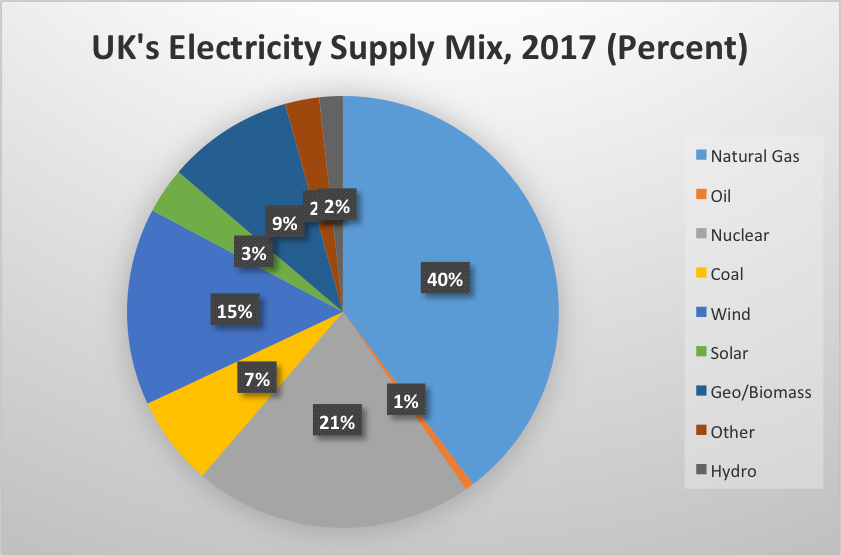The United Kingdom’s wind farm capacity increased by over 10 percent from last year, but the share of electricity the wind turbines supplied decreased—from 12.9 percent of generation last summer to 10.4 percent this summer because of a weather system that resulted in much of the country under a heat wave with suppressed wind conditions. Like wind capacity, the U.K.’s solar capacity also increased—from 11.3 gigawatts in April, 2017 to 12.1 gigawatts this year. The sunny weather resulted in a record level of generation from solar power. Despite that, wind and solar combined could not satisfy electricity demand. The country had to use its nuclear plants and its natural gas capacity to ensure sufficient electricity was available, indicating the need for a diverse energy supply. The lower wind generation also resulted in higher carbon dioxide emissions for the U.K. during the summer heat wave.
In 2017, the U.K. generated 48 percent of its electricity from fossil fuels, of which the majority was natural gas. Renewable energy (hydro, wind, solar, and biomass) provided 29 percent, and nuclear provided 21 percent. The U.K. is the world’s largest offshore wind generator, with just over 7 gigawatts of offshore wind capacity in operation and another 7 gigawatts under construction or secured in contracts.

The U.K. has comprehensive incentives for renewable energy that are being reviewed for their efficacy and costs. As a result, electricity prices are higher in the U.K. than in the United States. Residential electricity prices in the U.K. averaged 17.66 Euro cents per kilowatt hour (20.66 U.S. cents per kilowatt hour) in the first half of 2017 and 18.56 cents per kilowatt hour (21.72 U.S. cents per kilowatt hour) in the second half of 2017. These prices are about 65 percent higher than U.S. residential electricity prices that averaged 12.9 cents per kilowatt hour in 2017.
U.K. Carbon Goals
The U.K. may not meet its clean energy targets despite the addition of wind and solar capacity. In 2017, renewable energy’s share of electricity generation in the U.K. increased by 4.8 percentage points—from 24.5 percent to 29.3 percent. While this increase puts the U.K. close to its 30 percent target for renewable-based electricity generation by 2020, the U.K. is unlikely to meet its 2020 renewable energy target because of little progress in the areas of renewable heat and transport.
The U.K.’s carbon budgets are five-year caps on greenhouse gas emissions that were established as part of the country’s 2008 Climate Change Act. The Act commits the U.K. to cutting 2050 greenhouse gas emissions by at least 80 percent compared to 1990 levels. To meet these levels, the U.K.’s Clean Growth Strategy envisages rolling out low-carbon heating and ending the sale of gasoline and diesel cars and vans by 2040. To aid in transport decarbonization, achieving cost parity of electric vehicles with internal combustion engines and developing smart charging would be important steps. For heat decarbonization, smart control and more efficient use of heat are envisioned along with trials and studies into the potential of hydrogen and biogas for heating.
Conclusion
The U.K. is well on its way to meet its renewable energy targets in its generating sector for 2020 with over 29 percent of its electricity currently being generated from renewable energy resources. However, the generating sector alone will not get the country to achieve its greenhouse gas target of 80 percent reduction by 2050 from 1990 levels. To accomplish that goal, reductions are needed in its transport and heat sectors, where little progress has been made to date. To achieve those goals, the U.K. may need to ban gasoline and diesel vehicles and take other actions to encourage reductions in the heating sector.



